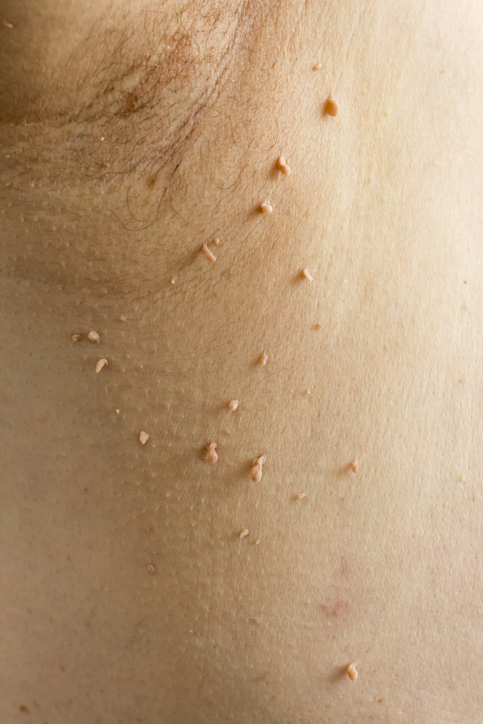
Removal of Skin Tags & Cherry Angiomas (red dots on the skin surface)
Skin Tags
Signs and Symptoms
An acrochordon or acrochorda: also known as a skin tag. Is a small tag that forms primarily in areas where the skin forms creases, such as the neck, armpits, and groin area or under breasts. They may also occur on the face, usually on the eyelids. Skin tags are harmless, annoying and usually painless. Though tags up to a half-inch long have been seen, they are typically the size of a grain of rice. Tags may become irritated by shaving, clothing, jewelry or heat.
Skin tags are prevalent in 46% of the general population. There is a genetic component, and they are also more common in women than in men.
Treatment
Skin tags frequently become irritated and are cosmetically unappealing. Because skin tags are benign, treatment is simple procedure. By means of electrocautery; a numbing cream is applied to the surface prior to treatment then a tiny probe with an electric current is applied to the skin tag to remove it quickly and painlessly.
Prognosis
In most patients, the number and size skin tags increases with advancing age. The good news removing a skin tag does not cause more to grow. Upon treatment the skin tag falls off, leaving a small scar that typically fades in a few months.
Cherry Angiomas (red dots on the skin surface)
Signs and Symptoms
Cherry angiomas also known as Campbell De Morgan spots or senile angiomas are made up of clusters of capillaries at the surface of the skin, forming a small round dome, or it may have a flat top. They first appear as a small red dot. However they usually grow from about a pinhead size up to 1/2 inch or more in size. As they grow larger, they tend to expand in thickness, and may take on a raised and rounded shape.
Causes
Cherry angiomas appear spontaneously in many people in middle age. They are unsightly but benign. Because the blood vessels of an angioma are so close the skin surface, cherry angiomas may bleed profusely if they are injured.
Treatment
These lesions are cosmetically unappealing and may be subject to bleeding, then angiomas may be removed by electrocautery, a numbing cream is applied to the surface prior to treatment then a tiny probe with an electric current is applied to the surface of the cherry angioma, to seal the capillaries shut thereby eliminating the red spot.
Prognosis
In most patients, the number and size of cherry angiomas increases with advancing age. They are harmless, having no relation to cancer at all. Upon treatment the cherry angioma capillaries are sealed shut, leaving only a memory or an insignificant dot that typically fades in a few months.
